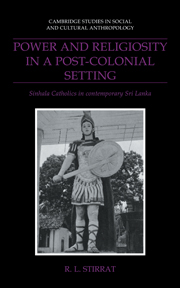Book contents
- Frontmatter
- Contents
- List of maps and figures
- List of tables
- Acknowledgements
- List of abbreviations
- Glossary
- Map 1 Sri Lanka
- Map 2 The west coast of Sri Lanka
- 1 Introduction
- 2 The colonial Church
- 3 The Church in crisis
- 4 The rise of Kudagama
- 5 Demonic possession and the battle against evil
- 6 Suffering and sacrifice
- 7 Holy men and power
- 8 Patronage and religion
- 9 On the borders
- 10 Conclusion
- Notes
- List of references
- Index
- Cambridge Studies in Social and Cultural Anthropology
10 - Conclusion
Published online by Cambridge University Press: 02 December 2009
- Frontmatter
- Contents
- List of maps and figures
- List of tables
- Acknowledgements
- List of abbreviations
- Glossary
- Map 1 Sri Lanka
- Map 2 The west coast of Sri Lanka
- 1 Introduction
- 2 The colonial Church
- 3 The Church in crisis
- 4 The rise of Kudagama
- 5 Demonic possession and the battle against evil
- 6 Suffering and sacrifice
- 7 Holy men and power
- 8 Patronage and religion
- 9 On the borders
- 10 Conclusion
- Notes
- List of references
- Index
- Cambridge Studies in Social and Cultural Anthropology
Summary
In his 1984 article on apparitions and the Cold War in Europe, Christian raises the issue of the degree to which religious phenomena can be seen in national terms:
Perhaps in the seventeenth to nineteenth centuries nation-states with national churches somewhat compartmentalised European religion, but in many respects the nation-state is no longer the real arena of culture. In 1947 a circuit of mutual influence could probably have been detected that linked the visions of Mercedes Trejo in Aldeamoret to the fanshen of a Chinese commune.
(1984: 259–60)There is always a temptation to view the sorts of phenomena I have been discussing in this book in terms of narrowly defined Sri Lankan parameters. After all, as has been pointed out throughout, there are many parallels between the behaviour of Sinhala Catholics and their Buddhist co-nationals, whilst the rise of shrines such as Kudagama can easily be paralleled by similar developments amongst Buddhists in Sri Lanka. It could be argued that despite well over a century of European missionary effort, and over three centuries of a Catholic presence, all that has transpired is a thin and ultimately fragile veneer of Catholic teachings over an essentially Sinhala style of popular religion.
This sort of conclusion has been reached by Susan Bayly in her massive work on Islam and Christianity in South India. She argues that, ‘the manifestations of Islam and Christianity which took root in south India’ should not be ‘dismissed as alien or marginal implants of European colonial rule’ but rather as ‘fully “Indian” religious systems’ (Bayly 1989: 454).
- Type
- Chapter
- Information
- Power and Religiosity in a Post-Colonial SettingSinhala Catholics in Contemporary Sri Lanka, pp. 195 - 203Publisher: Cambridge University PressPrint publication year: 1992



